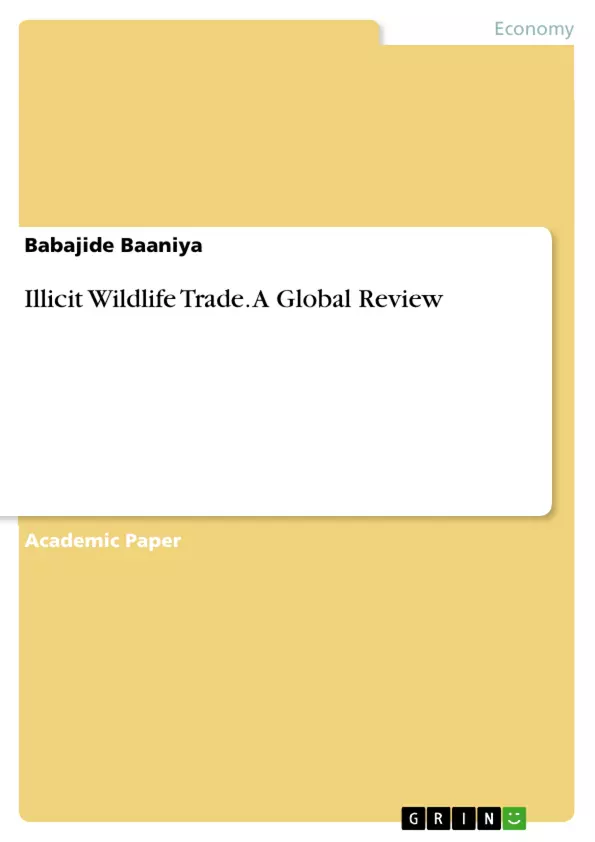Illicit Wildlife Trade refers to the commerce of products that are derived from non-domesticated animals or plants usually extracted from their natural environment or raised under control conditions.
“lllicit wildlife trafficking” describes any environment-related crime that involves the illegal trade, smuggling, poaching, capture or collection of endangered species, protected wildlife (including animals and plants that are subject to harvest quotas and regulated by permits), derivatives or products thereof.
Poaching has traditionally been defined as the illegal hunting or capturing of wild animals, usually associated with land use rights. And Game cropping is defined as the taking of animals from a wild herd in numbers that will not endanger the viability of the wild population
Most of the trade in wildlife is legal and provides much-needed revenue to range areas or source countries, many of which are located in developing countries or countries with economies in transition. However, according to Zimmerman, “The black market in illegal wildlife is now the second largest in the world—ranking only behind the trade in illegal drugs.” Therefore, the illegal trade, according to Cook et al, not only threatens survival and conservation of endangered species but also offers high rewards and low risks to those involved.
Inhaltsverzeichnis (Table of Contents)
- CHAPTER ONE.
- 1.1 INTRODUCTION
- 1.2 The Extent of the Illegal Trade
- 1.3 The Activities
- 1.4 Economic Value of Illegal Wildlife Trade.
- CHAPTER TWO.....
- 2.1 Overview of Illicit Trade in Wildlife.
- 2.2 Regional overviews..
- 2.3 Major Illegal Wildlife Products and Markets.
- 2.3.1 Rhino horn.....
- 2.3.2 IVORY.
- CHAPTER THREE
- 3.1 Causes of Illicit Wildlife Trade
- 3.2 The Contributing Factors.
- 3.3 Implications of Illicit Wildlife Trade..
- 3.3.1 Implications for Natural Wealth, Environment and Biodiversity.
- 3.3.2 Implications for Global Health.....
- 3.3.3 Implications for Social and Economic Development..
- 3.3.4 Implications for National and International Security
- CHAPTER FOUR.........
- 4.1 Efforts Made To Tackle Illegal Wildlife Trade..
- 4.1.1 Combating the Illegal Trade in African Elephant Ivory with DNA Forensics
- 4.1.2 Global Efforts to Stop Illicit Wildlife Trade.
- 4.2 Ongoing Efforts to Stop Illicit Wildlife Trade..
- 4.2.1 Law Enforcement Training On Ivory Seizures in East Africa....
- 4.2.2. Mobile Tiger Patrols in Sumatra, Indonesia
- 4.3. Way Out Of Illicit Wildlife Trade.....
- 4.3.1 Awareness and Education
- 4.3.2. Enforcement....
Zielsetzung und Themenschwerpunkte (Objectives and Key Themes)
This seminar paper presents a comprehensive overview of the illicit wildlife trade, exploring its global dimensions, causes, implications, and efforts made to combat it. The paper aims to raise awareness about the severity of this issue and highlight the importance of international cooperation in tackling this complex and multifaceted problem.- The extent and economic value of the illegal wildlife trade.
- The various activities and market dynamics involved in illicit wildlife trafficking.
- The causes and implications of illicit wildlife trade for natural resources, global health, social and economic development, and national and international security.
- The efforts made by various stakeholders to address the problem, including law enforcement, education, and awareness campaigns.
- The importance of international cooperation in combating this global issue.
Zusammenfassung der Kapitel (Chapter Summaries)
- Chapter One: Introduces the concept of illicit wildlife trade and its various forms, including the definition of poaching and game cropping. The chapter further discusses the vast scale of the illegal trade and its detrimental impact on endangered species and natural resources. The economic value of the illegal wildlife trade is also explored, highlighting its significance as a lucrative black market activity.
- Chapter Two: Provides an overview of the illicit trade in wildlife, detailing its global reach and impact. It discusses the illegal trade in specific wildlife products, such as rhino horn and ivory, and explores their market dynamics. The chapter also highlights the alarming increase in poaching activities in recent years, particularly targeting elephants and rhinos.
- Chapter Three: Examines the root causes and far-reaching implications of illicit wildlife trade. It investigates the contributing factors, such as poverty, corruption, and weak law enforcement. The chapter then delves into the detrimental impacts on natural resources, biodiversity, global health, social and economic development, and national and international security.
- Chapter Four: Focuses on the various efforts made to address the illegal wildlife trade, encompassing both past and ongoing initiatives. It highlights the use of DNA forensics in combating ivory trafficking and explores global efforts to stop the illicit trade. The chapter also examines specific ongoing initiatives such as law enforcement training and mobile tiger patrols. It concludes by exploring potential solutions, emphasizing the need for awareness and education, as well as robust enforcement mechanisms.
Schlüsselwörter (Keywords)
Illicit wildlife trade, poaching, endangered species, rhino horn, ivory, CITES, global health, biodiversity, environmental crime, law enforcement, international cooperation, awareness campaigns.- Quote paper
- Babajide Baaniya (Author), 2017, Illicit Wildlife Trade. A Global Review, Munich, GRIN Verlag, https://www.grin.com/document/412639



